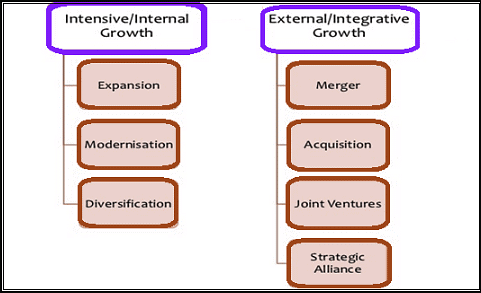UPSC Exam > UPSC Notes > Management Optional Notes for UPSC > Growth Strategies
Growth Strategies | Management Optional Notes for UPSC PDF Download
| Table of contents |

|
| Introduction |

|
| Internal growth strategy |

|
| Integration |

|
| External Growth Strategies |

|
Introduction
- Firms often employ growth strategies as a key competitive tactic to bolster their position in the market, as noted by Harrison (2013). Numerous studies highlight the correlation between organizational growth and economic development, emphasizing the internal processes at play within the firm (Penrose, E.T, 1959). The concept of firm growth as a path-dependent process is supported by Akpinar (2009), who suggests that as firms expand, they gain access to more resources.
- The resource-based view posits that a firm's growth is propelled by its unique set of resources and capabilities, with growth strategies being formulated based on these assets (Otto and Low 1998). These strategies typically aim for an increase in size and the expansion of current operations. Implementing a growth strategy involves various approaches, contingent on factors such as the firm's financial standing, competition, and government directives.
- Companies must consider specific methods for executing a growth strategy, with their choice often influenced by market conditions. Common growth strategies in business encompass market penetration, market expansion, product expansion, diversification, and acquisition.
Types of Growth Strategies: Two types of growth strategies are developed that include Internal and External.
Internal growth strategy
- Internal growth strategies involve various actions to expand a business, including:
- Designing and creating new products or services.
- Building on existing products or services to find new opportunities.
- Increasing sales of products or services by reaching more customers.
- Expanding current product lines and services.
- Exploring new markets and potentially expanding into foreign markets.
Question for Growth StrategiesTry yourself: What does market penetration strategy focus on?View Solution
Ansoff Product Marketing Expansion Grid:
- The Ansoff product and market growth matrix helps businesses plan their growth by considering whether their products and markets are new or existing.
- Developed by H. Igor Ansoff, the matrix presents four marketing strategies:
- Market Penetration.
- Product Development.
- Market Development.
- Diversification.
Ansoff product market growth strategy (Dhirendra Kumar, 2010)

Market Penetration:
- Involves selling existing products in existing markets.
- Focuses on boosting sales through effective marketing strategies within the current market.
- Aims to increase market share, become a leading player, drive out competitors, and encourage current customers to use products more.
Market Development:
- Identifies new market segments for existing products.
- Involves expanding into new user groups or geographic locations.
- Current products can be marketed differently or targeted to different customer segments.
Product Development:
- Involves modifying existing products to create new offerings.
- Aims to enhance sales through new products or services.
- Businesses with existing markets may develop additional products to cater to current customers.
Integration
Vertical Integration:
- Vertical integration means a company owns suppliers and buyers in its industry's supply chain.
- It involves moving forward or backward in the supply chain through acquisitions or partnerships.
- Backward integration: Company owns suppliers of inputs.
- Forward integration: Company owns subsidiaries that market the product.
- Balanced integration: Company sets up subsidiaries for both inputs and marketing.
- Advantages: Reduced costs, better supply chain coordination, increased control, and market dominance.
- Disadvantages: Higher costs, less flexibility, bureaucratic issues, and market monopolization.
Horizontal Integration:
- It involves acquiring or merging with companies in the same industry.
- Aims to grow the company, improve product variety, achieve economies of scale, and enter new markets.
- Advantages: Economies of scale and scope, global market reach, and resource sharing.
- Disadvantages: Increased costs, workload, antitrust concerns, and potential monopoly creation.
Diversification:
- Diversification aims to increase sales and profits through new products or markets.
- Two types: Related (in the same industry) and unrelated (different industries).
- Related diversification aims for synergy and strategic fit.
- Unrelated diversification aims to acquire valuable assets but carries higher risk.
- Advantages: Increased profits and opportunities.
- Disadvantages: Risky, potential for poor performance, and lack of industry experience.

External Growth Strategies
Strategic Alliances:
- A strategic alliance involves sharing resources or partnering to improve efficiency.
- Focuses on resource sharing without changing control or investing in each other's companies.
- Not about buying equity in each other's companies.
Merger:
- In a merger, two companies agree to become one new company.
- Can be between equals, a large company merging with a smaller one, or a voluntary process with both companies' consent.
Joint Venture:
- A joint venture creates a new entity where parties contribute resources like personnel, equipment, or cash.
- Parties agree on governance and profit-sharing structures.
- Can be for a specific project or an ongoing business relationship.
Acquisition:
- Acquisition is when one company takes over another, becoming the sole owner.
Question for Growth StrategiesTry yourself: Which type of growth strategy involves reaching more customers to increase sales of products or services?View Solution

Summary of Growth Strategies
- Growth strategies help firms compete in tough markets by achieving success.
- Internal growth happens by increasing sales or introducing new products while keeping the old ones.
- Horizontal internal growth means creating new companies in related or unrelated fields.
- Vertical internal growth involves forming businesses within the firm's supply chain.
- External growth includes mergers, acquisitions, joint ventures, and vertical integration.
The document Growth Strategies | Management Optional Notes for UPSC is a part of the UPSC Course Management Optional Notes for UPSC.
All you need of UPSC at this link: UPSC
FAQs on Growth Strategies - Management Optional Notes for UPSC
| 1. What is an internal growth strategy? |  |
Ans. An internal growth strategy refers to a business strategy that focuses on expanding and increasing revenues and market share through internal means. This can be achieved by investing in research and development, improving operational efficiency, launching new products or services, or entering new markets with existing products. Internal growth strategies are often preferred as they allow businesses to have more control over the expansion process.
| 2. What is integration as a growth strategy? |  |
Ans. Integration, as a growth strategy, refers to the process of combining or merging two or more companies in order to expand and achieve growth. There are two types of integration: horizontal integration and vertical integration. Horizontal integration involves merging with or acquiring companies that operate in the same industry or market, while vertical integration involves merging with or acquiring companies that operate at different stages of the supply chain.
| 3. What are external growth strategies? |  |
Ans. External growth strategies are business strategies that focus on achieving growth through external means, such as mergers, acquisitions, strategic alliances, or joint ventures. These strategies allow businesses to expand their operations, enter new markets, gain access to new technologies or resources, and increase their market share. External growth strategies are often used when internal growth opportunities are limited or when businesses want to achieve rapid expansion.
| 4. How can a business implement an internal growth strategy? |  |
Ans. A business can implement an internal growth strategy by focusing on various areas such as research and development, innovation, operational efficiency, and market penetration. This can involve investing in research and development to create new products or improve existing ones, streamlining operations to reduce costs and improve productivity, and implementing effective marketing and sales strategies to increase market share. Additionally, businesses can also explore opportunities for expanding into new markets or diversifying their product offerings.
| 5. What are the advantages of external growth strategies? |  |
Ans. External growth strategies offer several advantages to businesses. They provide opportunities for rapid expansion and market entry, allowing businesses to quickly gain access to new markets, technologies, or resources. External growth strategies also enable businesses to achieve economies of scale, increase their market share, and enhance their competitiveness. Moreover, these strategies can help businesses diversify their risk by entering new markets or industries, and can also lead to increased profitability and shareholder value.
Related Searches














